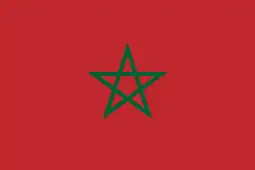| Great Mosque of Salé | |
|---|---|
المسجد الأعظم | |
 | |
| Location | |
| Location | Salé, Morocco |
| Geographic coordinates | 34°02′24″N 06°49′39″W / 34.04000°N 6.82750°W |
| Architecture | |
| Type | Mosque |
| Groundbreaking | 1028 |
| Completed | 1029 (rebuilt in 1196 and in 18th century) |
The Great Mosque of Salé (Arabic: المسجد الأعظم, Masjid Al Aadam) is a mosque in Salé, Morocco. Covering an area of 5,070 m2 (54,600 sq ft), it is the third-largest mosque in Morocco, and was originally built between 1028 and 1029.[1] It has been destroyed and rebuilt several times since the original construction. It was built in Almoravid and Almohad architectural styles, and the mosque features nine gates.[2] It was severely damaged in the Bombardment of Salé of 1851, and was briefly closed during the French protectorate in Morocco.
History

The mosque has been destroyed and rebuilt many times since the beginning of the city's history.[1] A first mosque was built under the orders of Temim Ibn Ziri from 1028 to 1029.[3] A new, larger mosque was built in 1196 under Abu Yusuf Yaqub al-Mansur's orders after the old mosque's roof had collapsed.[4] The architect of the Almohad building was known as al-Gharnati – a name which suggests he was from Granada in Al-Andalus.[5] According to historian Abd Al-Mun'im Al-Hasidi, 700 French slaves were involved in the reconstruction under al-Mansur's orders.[3]
In 1260 Salé was sacked and occupied by Castilian forces,[4] during which 3000 women, children and elderly residents of the city were gathered in the mosque and taken as slaves for Seville.[1] The Marinid sultan Abu Yusuf Yaqub reconquered the city soon afterwards. In 1342 another Marinid sultan, Abu al-Hasan, built the Madrasa of Abu al-Hasan next to the mosque, adding to its development as a religious and intellectual center of the city.[4]
The mosque was largely rebuilt and modified over time, and its present appearance dates from the 18th century, when the city was part of the Republic of Bou Regreg.[4] In 1851, Salé was bombarded by French forces, and the mosque was severely damaged after being struck by six cannonballs.[6]
During the French protectorate in Morocco, the mosque was used for nationalist gatherings in the 1930s, led by people such as Said Hajji, Ahmed Maaninou, Boubker el-Kadiri, and Abu Bakr Zniber.[7] The French protectorate later closed the mosque to prevent it being used as a place to awaken awareness of nationalist sentiment, but it later re-opened.[7]
Gallery
.jpg.webp) The minaret of the mosque
The minaret of the mosque The main courtyard (sahn) of the mosque
The main courtyard (sahn) of the mosque The gallery around the courtyard
The gallery around the courtyard Inside the prayer hall of the mosque
Inside the prayer hall of the mosque
See also
References
- 1 2 3 Mrini, Driss; Alaoui, Ismaïl (1997). Salé: cité millenaire (in French). Rabat: Editions Eclat. pp. 45–46. ISBN 9789981999503. Archived from the original on 2023-11-26. Retrieved 2020-10-02.
- ↑ "Great Mosque of Salé". Wassila. Archived from the original on 2 December 2014. Retrieved 23 November 2014.
- 1 2 "وزارة الأوقاف و الشؤون الإسلامية" (in Arabic). Islamic Morocco. Archived from the original on 24 February 2011. Retrieved 23 November 2014.
- 1 2 3 4 Mouline, Saïd (2008). "Rabat. Salé – Holy Cities of the Two Banks". The City in the Islamic World. Vol. 1. Brill. pp. 643–662. ISBN 9789004171688.
- ↑ Janet L. Abu-Lughod (1980). Rabat: Urban Apartheid in Morocco. Princeton University Press. p. 57. ISBN 978-1-4008-5303-8.
- ↑ Muḥammad bin 'Alī Dukkālī (1986). Al-Ithaf Al Wajiz, Tarikh Al-Adwatayn (in Arabic). Salā, al-Maghrib: al-Khizānah al-ʻIlmīyah al-Ṣabīḥīyah. p. 337. OCLC 427353826.
- 1 2 ʻAbd al-Raʼūf ibn ʻAbd al-Raḥmān Ḥajjī (2007). Saïd Hajji : naissance de la presse nationale Marocaine. Lebonfon Inc. ISBN 9780973223613. OCLC 183181000.

